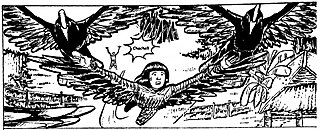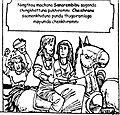
The Ashtabharya or Ashta-bharya(s) is the group of eight principal queen-consorts of Hindu god Krishna, the king of Dvaraka, Saurashtra in the Dvapara Yuga (epoch). The most popular list, found in the Bhagavata Purana, includes: Rukmini, Jambavati, Satyabhama, Kalindi, Nagnajiti, Mitravinda, Lakshmana and Bhadra. Variations exist in the Vishnu Purana and the Harivamsa, which includes queens called Madri or Rohini, instead of Bhadra. Most of them were princesses.

Irai Leima is a goddess in Sanamahism, the indigenous religion of Manipur. She is the goddess and the divine female personification of water and aquatic life. She is the consort of Irai Ningthou. Both are regarded as the divine spirits of water bodies. She is also considered to be in charge of diseases.

The Henjunaha Lairoulembi, also known as the Henjunaha Lairuklembi, shortly known as the Henjunaha, is a legendary epic love story of Henjunaha Yangleingamba and Thongnang Lairoulembi. It is one of the epic cycles of incarnations of Meitei mythology and folklore, that is originated from Moirang province of Ancient Kangleipak.

Yenakha Paotapi or Yenakha Paodabi Saijin Polibi, also known as the evil eavesdropper, is an old demoness. Stories often show her as an evil spirit. She lingers around the eaves of roofs in Meitei mythology and folklore of Ancient Kangleipak. She is described as the one who interferes everywhere. Legend says that she could not live with human beings. Instead, she lives like a dog or a jackal, sitting on graves. In some cases, she is depicted as a minor goddess in the Meitei religion.
Champavati is an Assamese folk tale. It was first collected in the compilation of Assamese folklore titled Burhi Aair Sadhu, by poet Lakshminath Bezbaroa. According to scholar Praphulladatta Goswami, the tale is "current in North Lakhimpur".

Lai Khutshangbi (/laai-khoot-shaang-bee/) is a demoness (hingchabi) in Meitei mythology and folklore of Antique Kangleipak. She has very long hands. The word "Lai" means "deity or divinity," "Khut" means "hand," and "Sangbi" or "Shangbi" means "long" in Manipuri (Meitei). The legend says that when she walks, her long hands touch the ground. Her fingers are as sharp as thorns. She has a large mouth with a long tongue. Her appearance is very frightening.

Keibu Keioiba, also known as Kabui Keioiba, is a mythical creature with the head of a tiger and the body of a human in the Meitei mythology and folklore of Manipur. He is often described as half man and half tiger.
Akongjamba was a nobleman in Ancient Moirang in Meitei mythology. He was a lover of the harvest Goddess Phouoibi. According to mythology, fate did not permit the lovers to unite, so they reincarnated. The lives of the two legendary lovers were believed to be enacted by Thangjing as a part of the epic cycles of incarnations.

In Meitei mythology and folklore, the epic cycles of incarnations in Moirang is a cyclic epic of seven incarnations of two divine lovers in the kingdom of Moirang in the realm of Ancient Kangleipak.

The ancient legend of Kadeng Thangjahanba and Tonu Laijinglembi is an epic cycle of incarnations of Meitei mythology and folklore from Moirang kingdom of Ancient Kangleipak. It concerns the fateful love of Kadeng Thangjahanba, a skilled blacksmith, for the beautiful Tonu Laijinglembi.

The ancient legend of Ura Naha Khongjomba and Pidonnu is an epic cycle of incarnations of Meitei mythology and folklore from the Moirang kingdom of Ancient Kangleipak. It concerns the love and adventures of the forgotten prince Ura Naha Khongjomba for the beautiful woman Pidonnu.

The ancient legend of Khamba and Thoibi is a classic, as well as one of the epic cycles of incarnations of Meitei mythology and folklore, that is originated from Ancient Moirang kingdom of Ancient Kangleipak . It is referred to as the "National Romantic Legend of Manipur" by Padma Vibhushan awardee Indian scholar Suniti Kumar Chatterjee.

The Meitei folktales, also sometimes referred to as the Manipuri folktales, are the large collections of folk stories developed from the Meitei culture since Ancient Kangleipak. Folktales are called "funga wari", literally meaning "stories of kitchen furnace or stove" in Meitei language. In early times, in the Meitei households, children must have gathered around the kitchen fire, listening to the stories narrated by the elders. Generally, Meitei folktales were developed from the creativity of the old folks, especially the grandparents, who narrated the children the diverse sagas of varying genres.

Haosi Namoinu is a character in Meitei mythology and folklore of Ancient Kangleipak. She is the only daughter of lady Pokmabi Laoshigam Chanu and lord Senbi Loikenba. She is the apple of their eyes. Her father was a minister of the then Ancient Moirang kingdom, in charge of collecting tributes from the land of Kabo.

Thabaton, lovingly called as Thaba, was a lady in Meitei mythology and folklore of Ancient Kangleipak. She had seven elder brothers who took care of her at every cost. She was kidnapped by Keibu Keioiba, a tiger headed man, during the absence of her siblings. After staying at the captivity of the beast for some time, she was later rescued and freed from bondage by her brothers.

The story of Uchek Langmeitong or Chekla Langmeitong is a Meitei folktale of Ancient Kangleipak. It is the story of a girl named "Hayainu" who turned herself into a Langmeitong as she was unable to suffer the ill treatments of her cruel stepmother.

Many pāmbīs play significant roles in the different elements of Meitei culture, including but not limited to Meitei cuisine, Meitei festivals, Meitei folklore, Meitei folktales, Meitei literature, Meitei mythology and Meitei religion (Sanamahism) of Kangleipak.
Ucheks have significant roles in different elements of Meitei culture, including but not limited to Meitei cuisine, Meitei dances, Meitei festivals, Meitei folklore, Meitei folktales, Meitei literature, Meitei mythology, etc.

Animals have significant roles in different elements of Meitei culture, including but not limited to Meitei cuisine, Meitei dances, Meitei festivals, Meitei folklore, Meitei folktales, Meitei literature, Meitei mythology, Meitei religion, etc.
Yairipok Thambalnu, originally known as Sanoujam Chanu Thambalnu or simply as Thambalnu, was a Meitei lady native to Yairipok region of Kangleipak. She was a victim of intrigues and was forced to meet a tragic death in drowning in a flooding river.
























